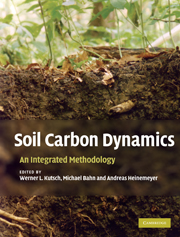Book contents
- Frontmatter
- Contents
- List of Contributors
- Preface
- Editorial Acknowledgements
- 1 Soil carbon relations: an overview
- 2 Field measurements of soil respiration: principles and constraints, potentials and limitations of different methods
- 3 Experimental design: scaling up in time and space, and its statistical considerations
- 4 Determination of soil carbon stocks and changes
- 5 Litter decomposition: concepts, methods and future perspectives
- 6 Characterization of soil organic matter
- 7 Respiration from roots and the mycorrhizosphere
- 8 Separating autotrophic and heterotrophic components of soil respiration: lessons learned from trenching and related root-exclusion experiments
- 9 Measuring soil microbial parameters relevant for soil carbon fluxes
- 10 Trophic interactions and their implications for soil carbon fluxes
- 11 Semi-empirical modelling of the response of soil respiration to environmental factors in laboratory and field conditions
- 12 Modelling soil carbon dynamics
- 13 The role of soils in the Kyoto Protocol
- 14 Synthesis: emerging issues and challenges for an integrated understanding of soil carbon fluxes
- 15 Appendix: Towards a standardized protocol for the measurement of soil CO2 efflux
- Index
- References
12 - Modelling soil carbon dynamics
Published online by Cambridge University Press: 11 May 2010
- Frontmatter
- Contents
- List of Contributors
- Preface
- Editorial Acknowledgements
- 1 Soil carbon relations: an overview
- 2 Field measurements of soil respiration: principles and constraints, potentials and limitations of different methods
- 3 Experimental design: scaling up in time and space, and its statistical considerations
- 4 Determination of soil carbon stocks and changes
- 5 Litter decomposition: concepts, methods and future perspectives
- 6 Characterization of soil organic matter
- 7 Respiration from roots and the mycorrhizosphere
- 8 Separating autotrophic and heterotrophic components of soil respiration: lessons learned from trenching and related root-exclusion experiments
- 9 Measuring soil microbial parameters relevant for soil carbon fluxes
- 10 Trophic interactions and their implications for soil carbon fluxes
- 11 Semi-empirical modelling of the response of soil respiration to environmental factors in laboratory and field conditions
- 12 Modelling soil carbon dynamics
- 13 The role of soils in the Kyoto Protocol
- 14 Synthesis: emerging issues and challenges for an integrated understanding of soil carbon fluxes
- 15 Appendix: Towards a standardized protocol for the measurement of soil CO2 efflux
- Index
- References
Summary
INTRODUCTION
The need for models of soil organic matter (SOM) turnover is similar to the need for many models of environmental processes: they are used to better understand processes; extrapolate or interpolate experimental results in time, space and to different environmental conditions; and to investigate scenarios and hypotheses that are beyond the realm of experimental work. As a result of this, a wide variety of SOM models have been developed, differing in their formulation and purpose. There are a number of approaches to modelling SOM turnover including process-based multi-compartment models, models that consider each fresh addition of plant debris as a separate cohort that decays in a continuous way, and models that account for carbon and nitrogen transfers through various trophic levels in a soil food web. This chapter aims to give a broad overview of currently available SOM models, highlighting areas of model application, identifying strengths and weaknesses and future directions for model development. We focus on two of the most widely used SOM models, RothC and CENTURY, to provide detailed case studies of model formulation, development and application.
SOIL ORGANIC MATTER MODELS
There are several sources of metadata and information on SOM models. CAMASE (Plentinger and Penning de Vries, 1996) contains 98 agro-ecosystems models having soil components, and the Global Change and Terrestrial Ecosystems Soil Organic Matter Network (GCTE-SOMNET) database (Smith et al., 1996a, 1996b: online at http://saffron.rothamsted.bbsrc.ac.uk/cgi-bin/somnet/) contains metadata on over 30 current operational SOM models. Several authors have previously reviewed SOM models extensively.
Information
- Type
- Chapter
- Information
- Soil Carbon DynamicsAn Integrated Methodology, pp. 221 - 244Publisher: Cambridge University PressPrint publication year: 2010
References
Accessibility standard: Unknown
Why this information is here
This section outlines the accessibility features of this content - including support for screen readers, full keyboard navigation and high-contrast display options. This may not be relevant for you.Accessibility Information
- 9
- Cited by
